Commercial Law Report: Analyzing Duty of Care and Negligence in Cases
VerifiedAdded on 2020/05/16
|12
|2873
|232
Report
AI Summary
This report examines a commercial law case involving Alice, who is accused of negligence towards her clients, Xi and Marcos, during a whale watching trip. The report analyzes the issues of duty of care, breach of duty, and the resulting damages suffered by Marcos due to an injury sustained on the boat. It explores the legal principles of negligence, including the application of the Donoghue v Stevenson case, and the elements required to establish a duty of care. The report also discusses the concept of breach of duty, foreseeability of risk, and the assessment of damages. Furthermore, it considers the defense of contributory negligence, where Marcos's actions may have contributed to his injury, potentially reducing Alice's liability. The analysis incorporates relevant legislation, such as the Civil Liability Act 2003 (Qld), and legal precedents to determine the extent of Alice's responsibility and Marcos's potential claims for damages. The conclusion finds Alice liable, but suggests a reduction in damages due to Marcos's contributory negligence.
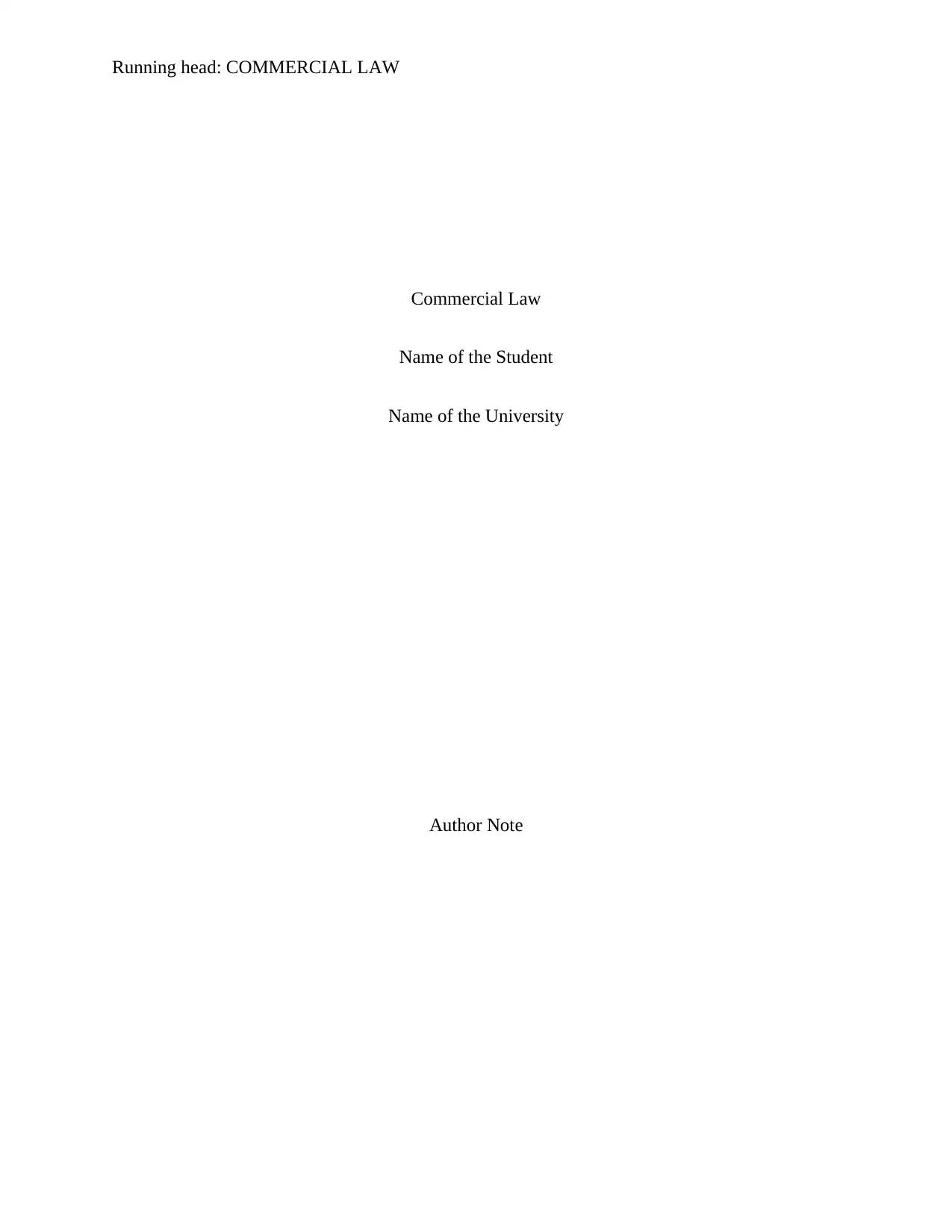
Running head: COMMERCIAL LAW
Commercial Law
Name of the Student
Name of the University
Author Note
Commercial Law
Name of the Student
Name of the University
Author Note
Paraphrase This Document
Need a fresh take? Get an instant paraphrase of this document with our AI Paraphraser
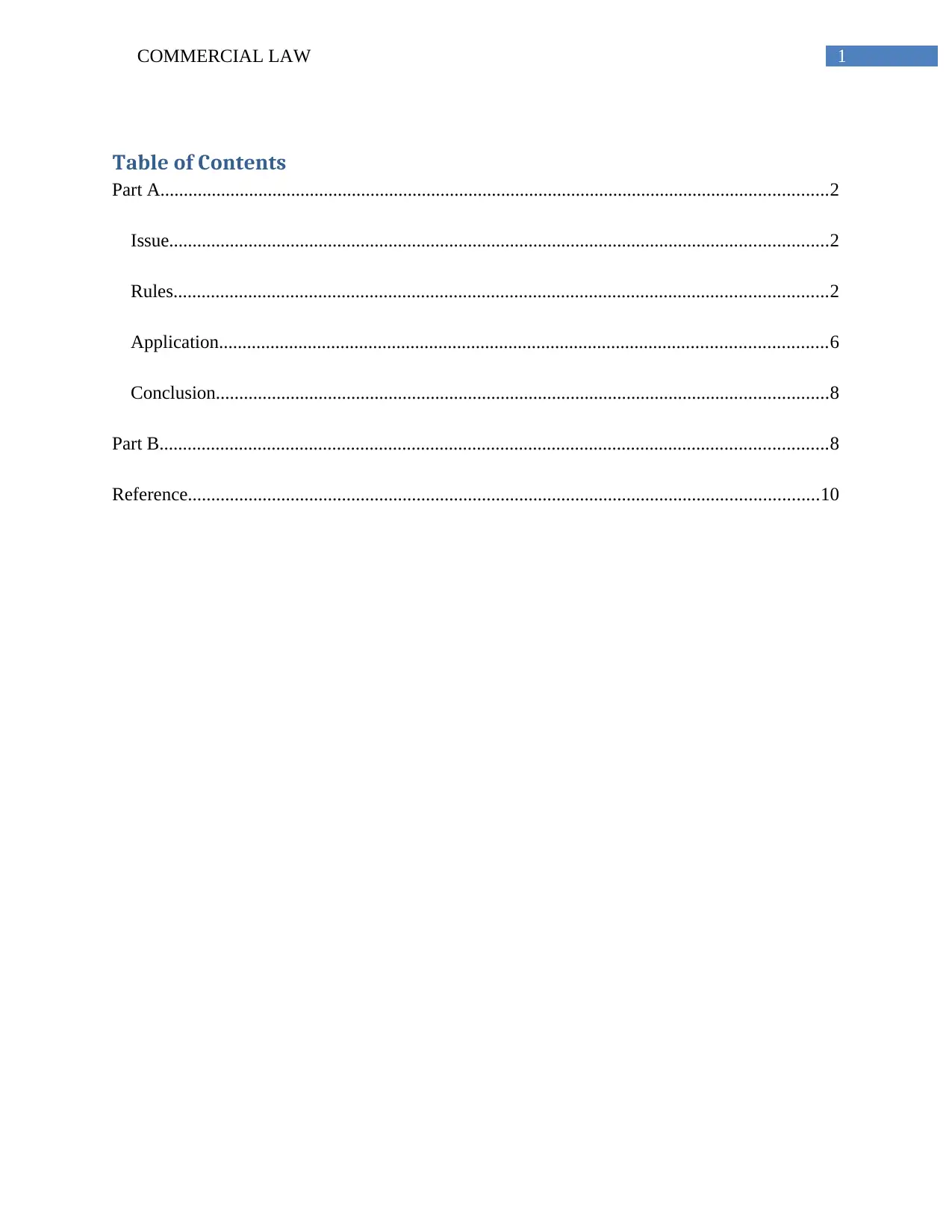
1COMMERCIAL LAW
Table of Contents
Part A...............................................................................................................................................2
Issue.............................................................................................................................................2
Rules............................................................................................................................................2
Application..................................................................................................................................6
Conclusion...................................................................................................................................8
Part B...............................................................................................................................................8
Reference.......................................................................................................................................10
Table of Contents
Part A...............................................................................................................................................2
Issue.............................................................................................................................................2
Rules............................................................................................................................................2
Application..................................................................................................................................6
Conclusion...................................................................................................................................8
Part B...............................................................................................................................................8
Reference.......................................................................................................................................10
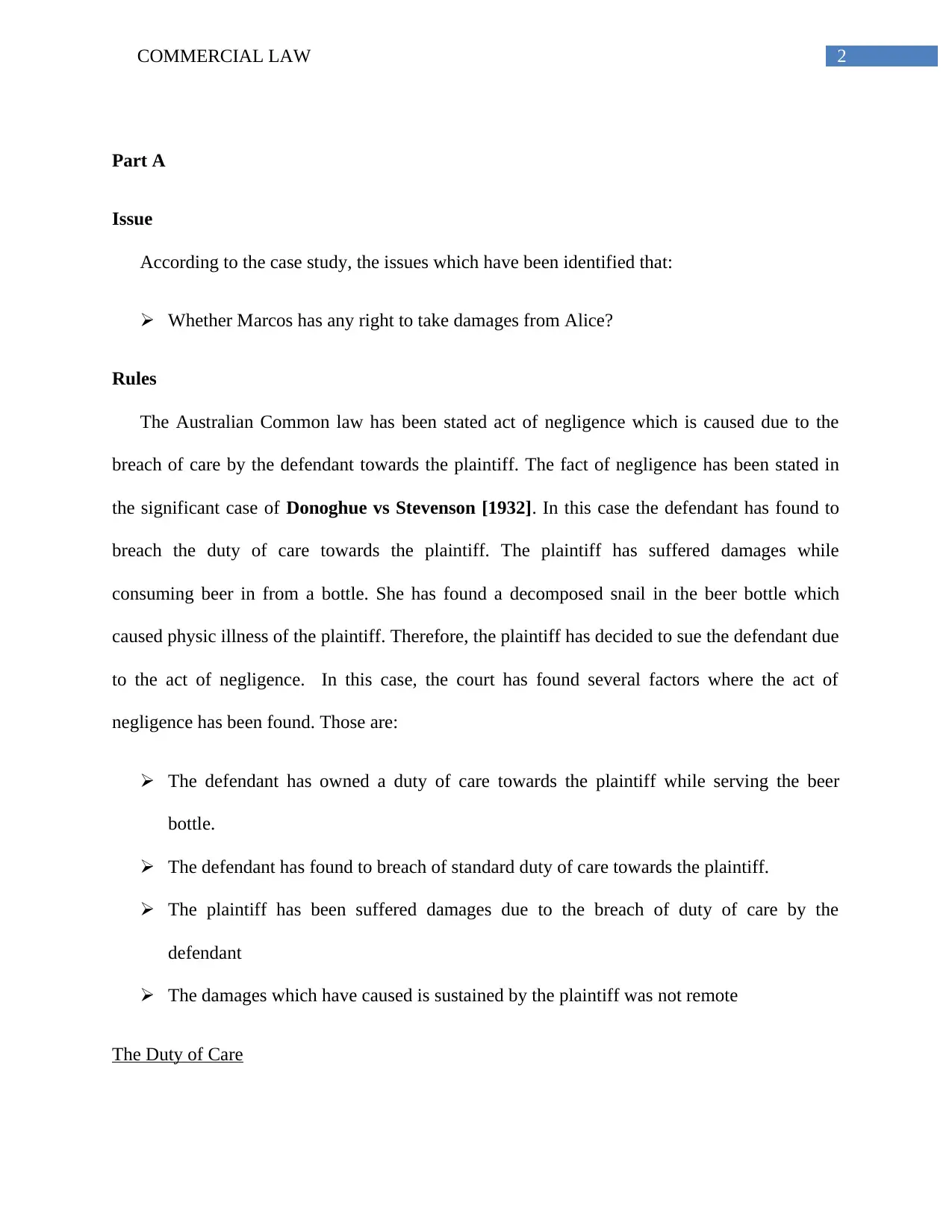
2COMMERCIAL LAW
Part A
Issue
According to the case study, the issues which have been identified that:
Whether Marcos has any right to take damages from Alice?
Rules
The Australian Common law has been stated act of negligence which is caused due to the
breach of care by the defendant towards the plaintiff. The fact of negligence has been stated in
the significant case of Donoghue vs Stevenson [1932]. In this case the defendant has found to
breach the duty of care towards the plaintiff. The plaintiff has suffered damages while
consuming beer in from a bottle. She has found a decomposed snail in the beer bottle which
caused physic illness of the plaintiff. Therefore, the plaintiff has decided to sue the defendant due
to the act of negligence. In this case, the court has found several factors where the act of
negligence has been found. Those are:
The defendant has owned a duty of care towards the plaintiff while serving the beer
bottle.
The defendant has found to breach of standard duty of care towards the plaintiff.
The plaintiff has been suffered damages due to the breach of duty of care by the
defendant
The damages which have caused is sustained by the plaintiff was not remote
The Duty of Care
Part A
Issue
According to the case study, the issues which have been identified that:
Whether Marcos has any right to take damages from Alice?
Rules
The Australian Common law has been stated act of negligence which is caused due to the
breach of care by the defendant towards the plaintiff. The fact of negligence has been stated in
the significant case of Donoghue vs Stevenson [1932]. In this case the defendant has found to
breach the duty of care towards the plaintiff. The plaintiff has suffered damages while
consuming beer in from a bottle. She has found a decomposed snail in the beer bottle which
caused physic illness of the plaintiff. Therefore, the plaintiff has decided to sue the defendant due
to the act of negligence. In this case, the court has found several factors where the act of
negligence has been found. Those are:
The defendant has owned a duty of care towards the plaintiff while serving the beer
bottle.
The defendant has found to breach of standard duty of care towards the plaintiff.
The plaintiff has been suffered damages due to the breach of duty of care by the
defendant
The damages which have caused is sustained by the plaintiff was not remote
The Duty of Care
⊘ This is a preview!⊘
Do you want full access?
Subscribe today to unlock all pages.

Trusted by 1+ million students worldwide
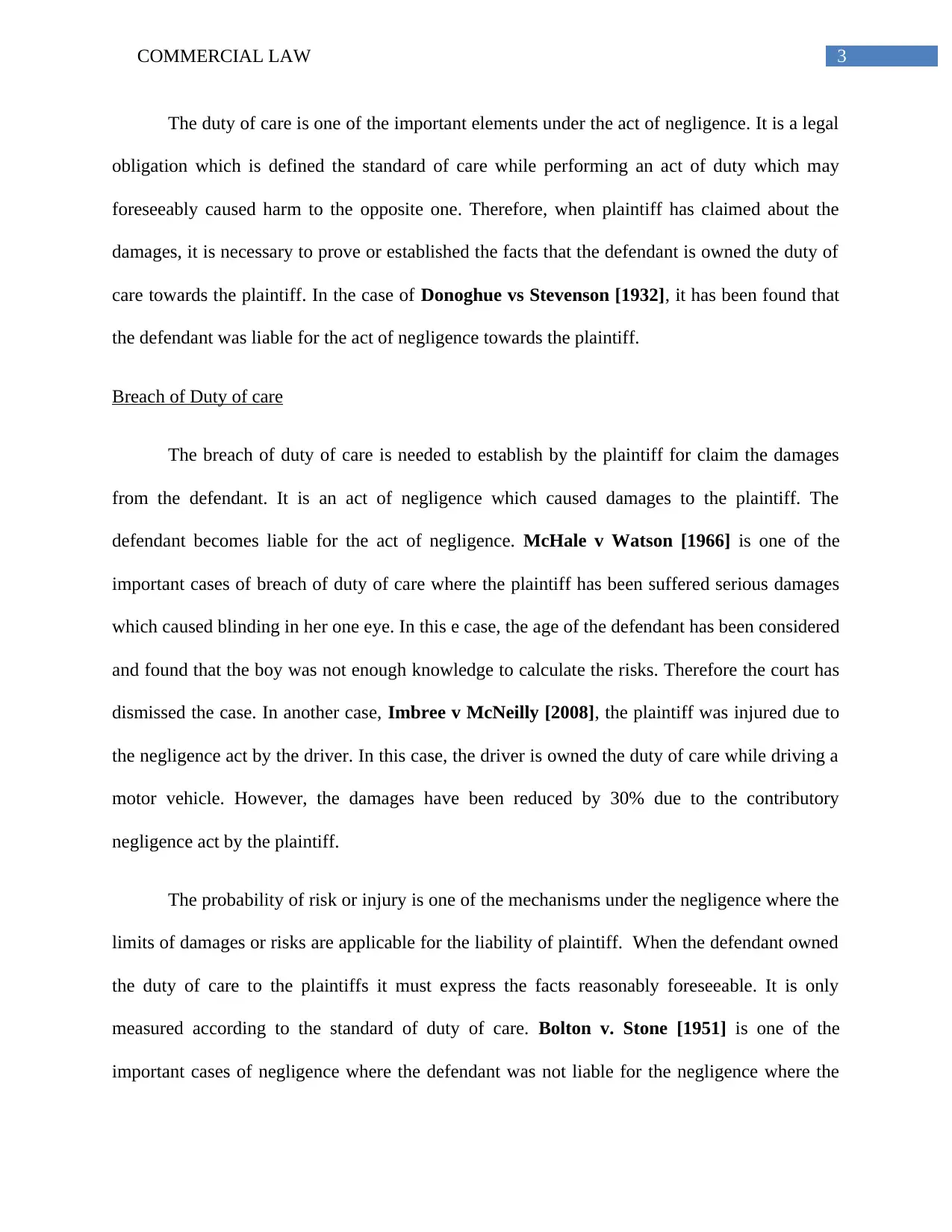
3COMMERCIAL LAW
The duty of care is one of the important elements under the act of negligence. It is a legal
obligation which is defined the standard of care while performing an act of duty which may
foreseeably caused harm to the opposite one. Therefore, when plaintiff has claimed about the
damages, it is necessary to prove or established the facts that the defendant is owned the duty of
care towards the plaintiff. In the case of Donoghue vs Stevenson [1932], it has been found that
the defendant was liable for the act of negligence towards the plaintiff.
Breach of Duty of care
The breach of duty of care is needed to establish by the plaintiff for claim the damages
from the defendant. It is an act of negligence which caused damages to the plaintiff. The
defendant becomes liable for the act of negligence. McHale v Watson [1966] is one of the
important cases of breach of duty of care where the plaintiff has been suffered serious damages
which caused blinding in her one eye. In this e case, the age of the defendant has been considered
and found that the boy was not enough knowledge to calculate the risks. Therefore the court has
dismissed the case. In another case, Imbree v McNeilly [2008], the plaintiff was injured due to
the negligence act by the driver. In this case, the driver is owned the duty of care while driving a
motor vehicle. However, the damages have been reduced by 30% due to the contributory
negligence act by the plaintiff.
The probability of risk or injury is one of the mechanisms under the negligence where the
limits of damages or risks are applicable for the liability of plaintiff. When the defendant owned
the duty of care to the plaintiffs it must express the facts reasonably foreseeable. It is only
measured according to the standard of duty of care. Bolton v. Stone [1951] is one of the
important cases of negligence where the defendant was not liable for the negligence where the
The duty of care is one of the important elements under the act of negligence. It is a legal
obligation which is defined the standard of care while performing an act of duty which may
foreseeably caused harm to the opposite one. Therefore, when plaintiff has claimed about the
damages, it is necessary to prove or established the facts that the defendant is owned the duty of
care towards the plaintiff. In the case of Donoghue vs Stevenson [1932], it has been found that
the defendant was liable for the act of negligence towards the plaintiff.
Breach of Duty of care
The breach of duty of care is needed to establish by the plaintiff for claim the damages
from the defendant. It is an act of negligence which caused damages to the plaintiff. The
defendant becomes liable for the act of negligence. McHale v Watson [1966] is one of the
important cases of breach of duty of care where the plaintiff has been suffered serious damages
which caused blinding in her one eye. In this e case, the age of the defendant has been considered
and found that the boy was not enough knowledge to calculate the risks. Therefore the court has
dismissed the case. In another case, Imbree v McNeilly [2008], the plaintiff was injured due to
the negligence act by the driver. In this case, the driver is owned the duty of care while driving a
motor vehicle. However, the damages have been reduced by 30% due to the contributory
negligence act by the plaintiff.
The probability of risk or injury is one of the mechanisms under the negligence where the
limits of damages or risks are applicable for the liability of plaintiff. When the defendant owned
the duty of care to the plaintiffs it must express the facts reasonably foreseeable. It is only
measured according to the standard of duty of care. Bolton v. Stone [1951] is one of the
important cases of negligence where the defendant was not liable for the negligence where the
Paraphrase This Document
Need a fresh take? Get an instant paraphrase of this document with our AI Paraphraser
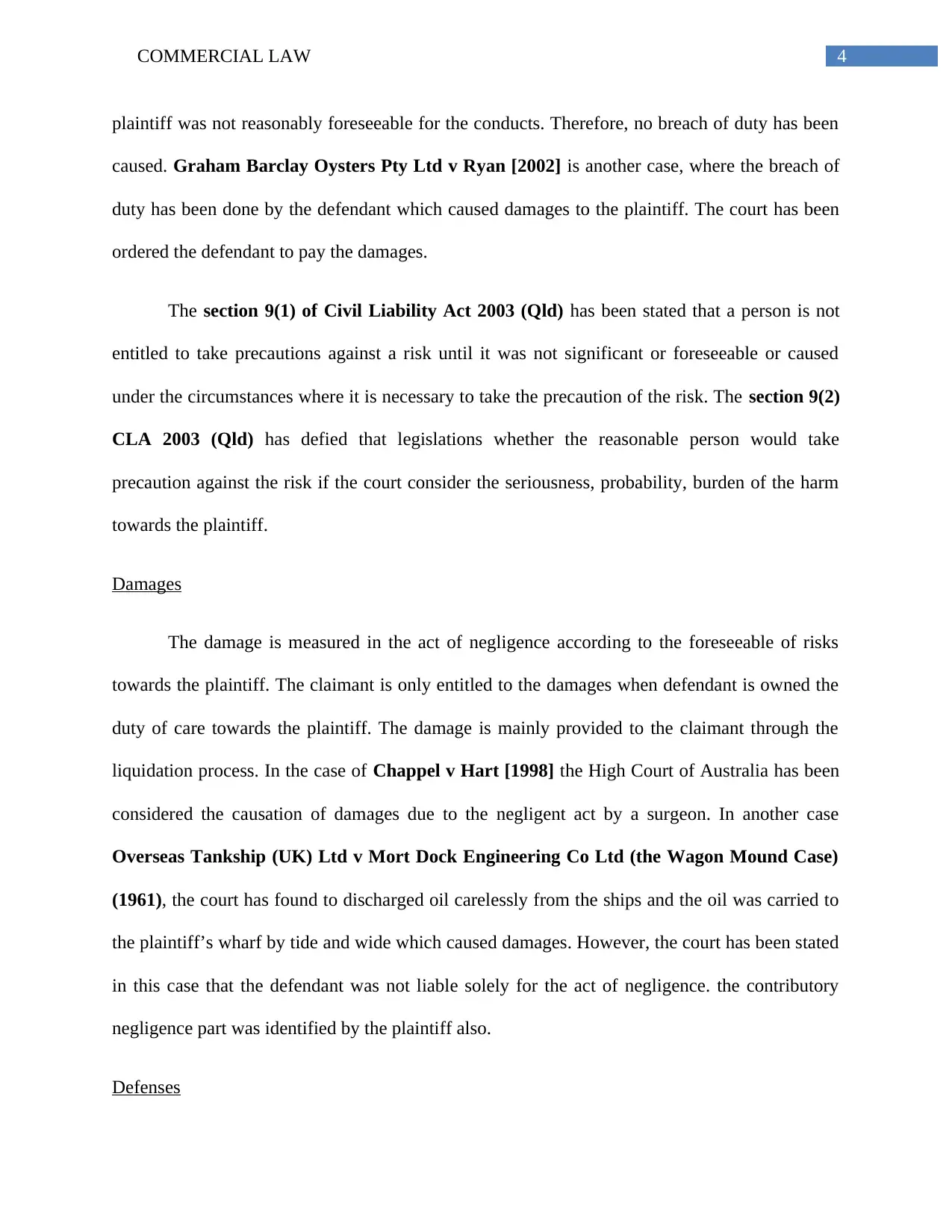
4COMMERCIAL LAW
plaintiff was not reasonably foreseeable for the conducts. Therefore, no breach of duty has been
caused. Graham Barclay Oysters Pty Ltd v Ryan [2002] is another case, where the breach of
duty has been done by the defendant which caused damages to the plaintiff. The court has been
ordered the defendant to pay the damages.
The section 9(1) of Civil Liability Act 2003 (Qld) has been stated that a person is not
entitled to take precautions against a risk until it was not significant or foreseeable or caused
under the circumstances where it is necessary to take the precaution of the risk. The section 9(2)
CLA 2003 (Qld) has defied that legislations whether the reasonable person would take
precaution against the risk if the court consider the seriousness, probability, burden of the harm
towards the plaintiff.
Damages
The damage is measured in the act of negligence according to the foreseeable of risks
towards the plaintiff. The claimant is only entitled to the damages when defendant is owned the
duty of care towards the plaintiff. The damage is mainly provided to the claimant through the
liquidation process. In the case of Chappel v Hart [1998] the High Court of Australia has been
considered the causation of damages due to the negligent act by a surgeon. In another case
Overseas Tankship (UK) Ltd v Mort Dock Engineering Co Ltd (the Wagon Mound Case)
(1961), the court has found to discharged oil carelessly from the ships and the oil was carried to
the plaintiff’s wharf by tide and wide which caused damages. However, the court has been stated
in this case that the defendant was not liable solely for the act of negligence. the contributory
negligence part was identified by the plaintiff also.
Defenses
plaintiff was not reasonably foreseeable for the conducts. Therefore, no breach of duty has been
caused. Graham Barclay Oysters Pty Ltd v Ryan [2002] is another case, where the breach of
duty has been done by the defendant which caused damages to the plaintiff. The court has been
ordered the defendant to pay the damages.
The section 9(1) of Civil Liability Act 2003 (Qld) has been stated that a person is not
entitled to take precautions against a risk until it was not significant or foreseeable or caused
under the circumstances where it is necessary to take the precaution of the risk. The section 9(2)
CLA 2003 (Qld) has defied that legislations whether the reasonable person would take
precaution against the risk if the court consider the seriousness, probability, burden of the harm
towards the plaintiff.
Damages
The damage is measured in the act of negligence according to the foreseeable of risks
towards the plaintiff. The claimant is only entitled to the damages when defendant is owned the
duty of care towards the plaintiff. The damage is mainly provided to the claimant through the
liquidation process. In the case of Chappel v Hart [1998] the High Court of Australia has been
considered the causation of damages due to the negligent act by a surgeon. In another case
Overseas Tankship (UK) Ltd v Mort Dock Engineering Co Ltd (the Wagon Mound Case)
(1961), the court has found to discharged oil carelessly from the ships and the oil was carried to
the plaintiff’s wharf by tide and wide which caused damages. However, the court has been stated
in this case that the defendant was not liable solely for the act of negligence. the contributory
negligence part was identified by the plaintiff also.
Defenses
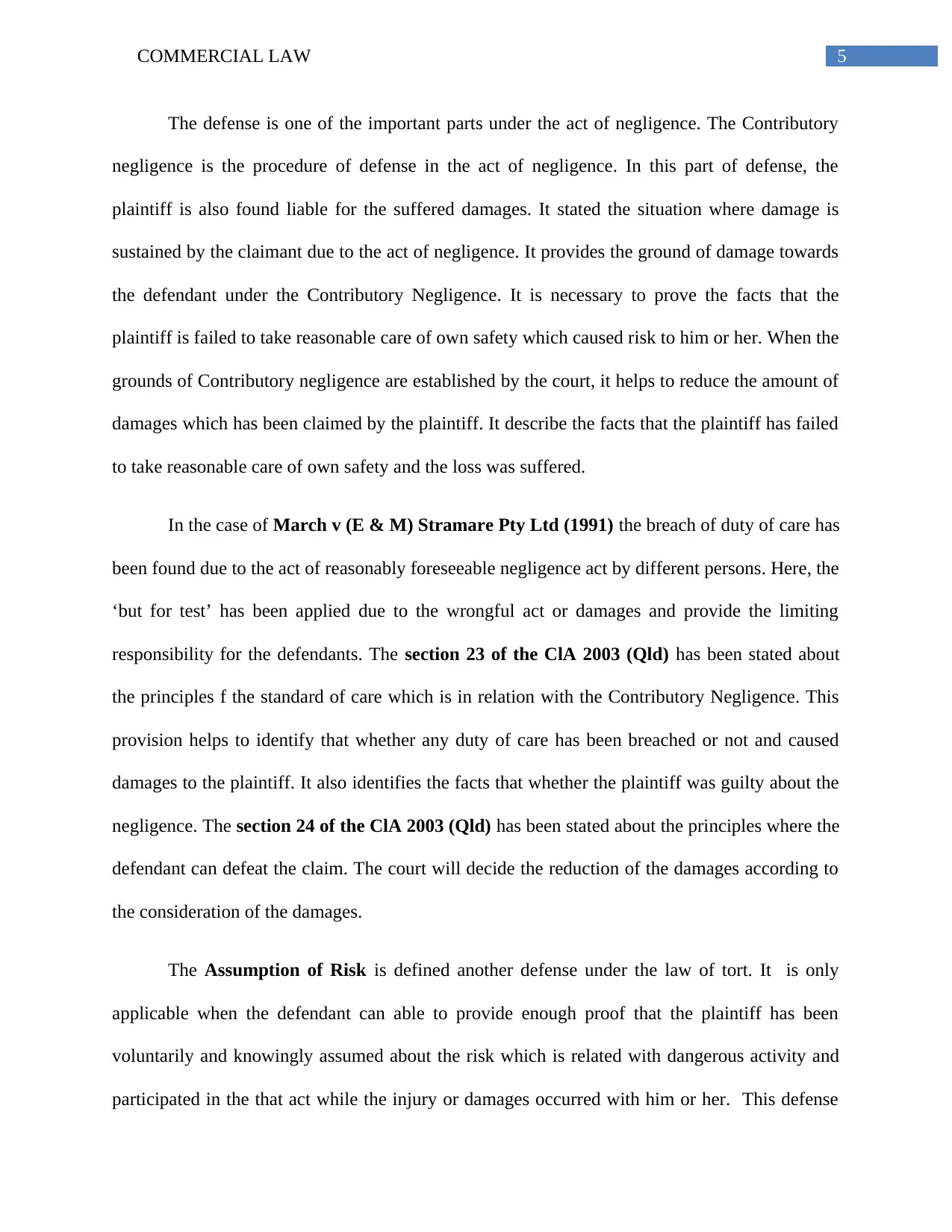
5COMMERCIAL LAW
The defense is one of the important parts under the act of negligence. The Contributory
negligence is the procedure of defense in the act of negligence. In this part of defense, the
plaintiff is also found liable for the suffered damages. It stated the situation where damage is
sustained by the claimant due to the act of negligence. It provides the ground of damage towards
the defendant under the Contributory Negligence. It is necessary to prove the facts that the
plaintiff is failed to take reasonable care of own safety which caused risk to him or her. When the
grounds of Contributory negligence are established by the court, it helps to reduce the amount of
damages which has been claimed by the plaintiff. It describe the facts that the plaintiff has failed
to take reasonable care of own safety and the loss was suffered.
In the case of March v (E & M) Stramare Pty Ltd (1991) the breach of duty of care has
been found due to the act of reasonably foreseeable negligence act by different persons. Here, the
‘but for test’ has been applied due to the wrongful act or damages and provide the limiting
responsibility for the defendants. The section 23 of the ClA 2003 (Qld) has been stated about
the principles f the standard of care which is in relation with the Contributory Negligence. This
provision helps to identify that whether any duty of care has been breached or not and caused
damages to the plaintiff. It also identifies the facts that whether the plaintiff was guilty about the
negligence. The section 24 of the ClA 2003 (Qld) has been stated about the principles where the
defendant can defeat the claim. The court will decide the reduction of the damages according to
the consideration of the damages.
The Assumption of Risk is defined another defense under the law of tort. It is only
applicable when the defendant can able to provide enough proof that the plaintiff has been
voluntarily and knowingly assumed about the risk which is related with dangerous activity and
participated in the that act while the injury or damages occurred with him or her. This defense
The defense is one of the important parts under the act of negligence. The Contributory
negligence is the procedure of defense in the act of negligence. In this part of defense, the
plaintiff is also found liable for the suffered damages. It stated the situation where damage is
sustained by the claimant due to the act of negligence. It provides the ground of damage towards
the defendant under the Contributory Negligence. It is necessary to prove the facts that the
plaintiff is failed to take reasonable care of own safety which caused risk to him or her. When the
grounds of Contributory negligence are established by the court, it helps to reduce the amount of
damages which has been claimed by the plaintiff. It describe the facts that the plaintiff has failed
to take reasonable care of own safety and the loss was suffered.
In the case of March v (E & M) Stramare Pty Ltd (1991) the breach of duty of care has
been found due to the act of reasonably foreseeable negligence act by different persons. Here, the
‘but for test’ has been applied due to the wrongful act or damages and provide the limiting
responsibility for the defendants. The section 23 of the ClA 2003 (Qld) has been stated about
the principles f the standard of care which is in relation with the Contributory Negligence. This
provision helps to identify that whether any duty of care has been breached or not and caused
damages to the plaintiff. It also identifies the facts that whether the plaintiff was guilty about the
negligence. The section 24 of the ClA 2003 (Qld) has been stated about the principles where the
defendant can defeat the claim. The court will decide the reduction of the damages according to
the consideration of the damages.
The Assumption of Risk is defined another defense under the law of tort. It is only
applicable when the defendant can able to provide enough proof that the plaintiff has been
voluntarily and knowingly assumed about the risk which is related with dangerous activity and
participated in the that act while the injury or damages occurred with him or her. This defense
⊘ This is a preview!⊘
Do you want full access?
Subscribe today to unlock all pages.

Trusted by 1+ million students worldwide
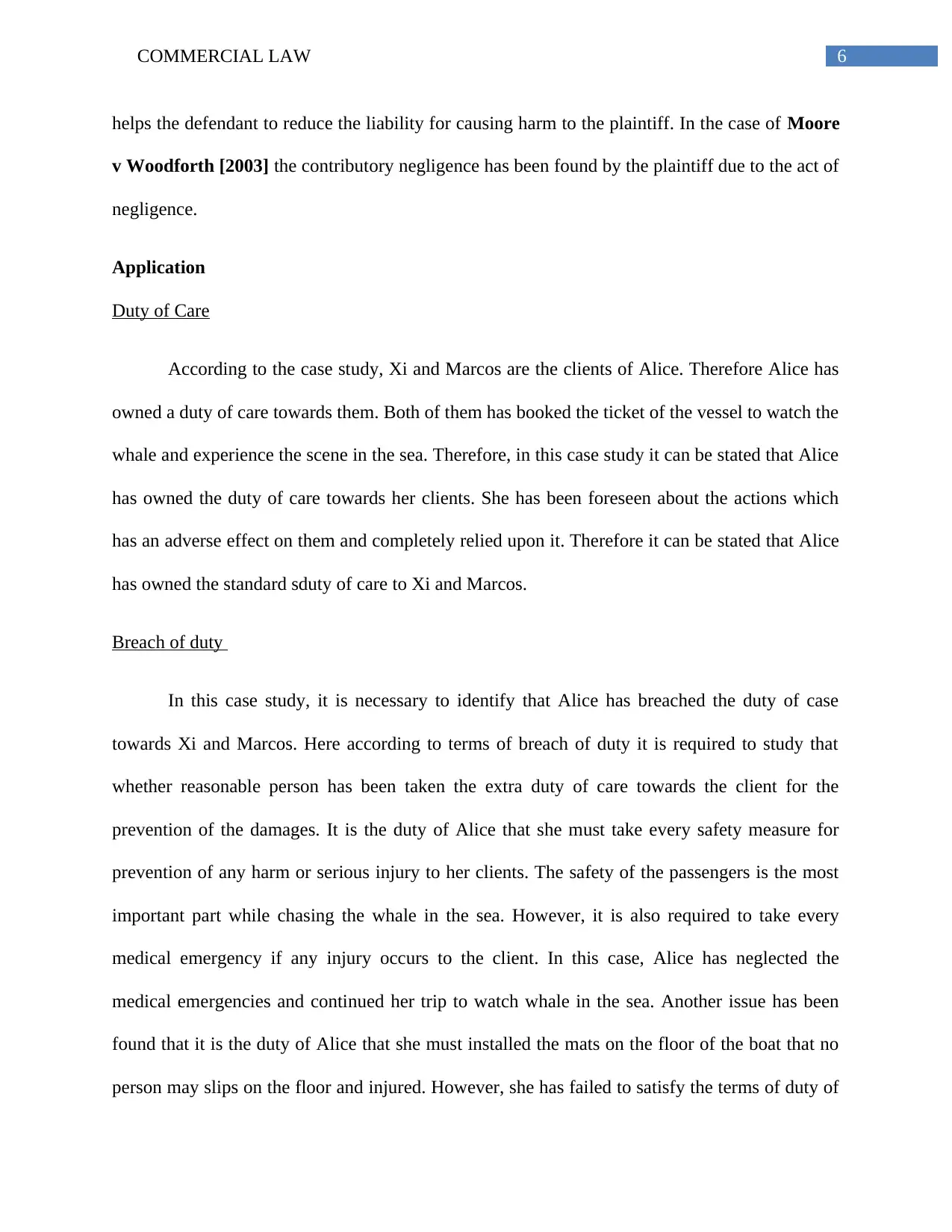
6COMMERCIAL LAW
helps the defendant to reduce the liability for causing harm to the plaintiff. In the case of Moore
v Woodforth [2003] the contributory negligence has been found by the plaintiff due to the act of
negligence.
Application
Duty of Care
According to the case study, Xi and Marcos are the clients of Alice. Therefore Alice has
owned a duty of care towards them. Both of them has booked the ticket of the vessel to watch the
whale and experience the scene in the sea. Therefore, in this case study it can be stated that Alice
has owned the duty of care towards her clients. She has been foreseen about the actions which
has an adverse effect on them and completely relied upon it. Therefore it can be stated that Alice
has owned the standard sduty of care to Xi and Marcos.
Breach of duty
In this case study, it is necessary to identify that Alice has breached the duty of case
towards Xi and Marcos. Here according to terms of breach of duty it is required to study that
whether reasonable person has been taken the extra duty of care towards the client for the
prevention of the damages. It is the duty of Alice that she must take every safety measure for
prevention of any harm or serious injury to her clients. The safety of the passengers is the most
important part while chasing the whale in the sea. However, it is also required to take every
medical emergency if any injury occurs to the client. In this case, Alice has neglected the
medical emergencies and continued her trip to watch whale in the sea. Another issue has been
found that it is the duty of Alice that she must installed the mats on the floor of the boat that no
person may slips on the floor and injured. However, she has failed to satisfy the terms of duty of
helps the defendant to reduce the liability for causing harm to the plaintiff. In the case of Moore
v Woodforth [2003] the contributory negligence has been found by the plaintiff due to the act of
negligence.
Application
Duty of Care
According to the case study, Xi and Marcos are the clients of Alice. Therefore Alice has
owned a duty of care towards them. Both of them has booked the ticket of the vessel to watch the
whale and experience the scene in the sea. Therefore, in this case study it can be stated that Alice
has owned the duty of care towards her clients. She has been foreseen about the actions which
has an adverse effect on them and completely relied upon it. Therefore it can be stated that Alice
has owned the standard sduty of care to Xi and Marcos.
Breach of duty
In this case study, it is necessary to identify that Alice has breached the duty of case
towards Xi and Marcos. Here according to terms of breach of duty it is required to study that
whether reasonable person has been taken the extra duty of care towards the client for the
prevention of the damages. It is the duty of Alice that she must take every safety measure for
prevention of any harm or serious injury to her clients. The safety of the passengers is the most
important part while chasing the whale in the sea. However, it is also required to take every
medical emergency if any injury occurs to the client. In this case, Alice has neglected the
medical emergencies and continued her trip to watch whale in the sea. Another issue has been
found that it is the duty of Alice that she must installed the mats on the floor of the boat that no
person may slips on the floor and injured. However, she has failed to satisfy the terms of duty of
Paraphrase This Document
Need a fresh take? Get an instant paraphrase of this document with our AI Paraphraser
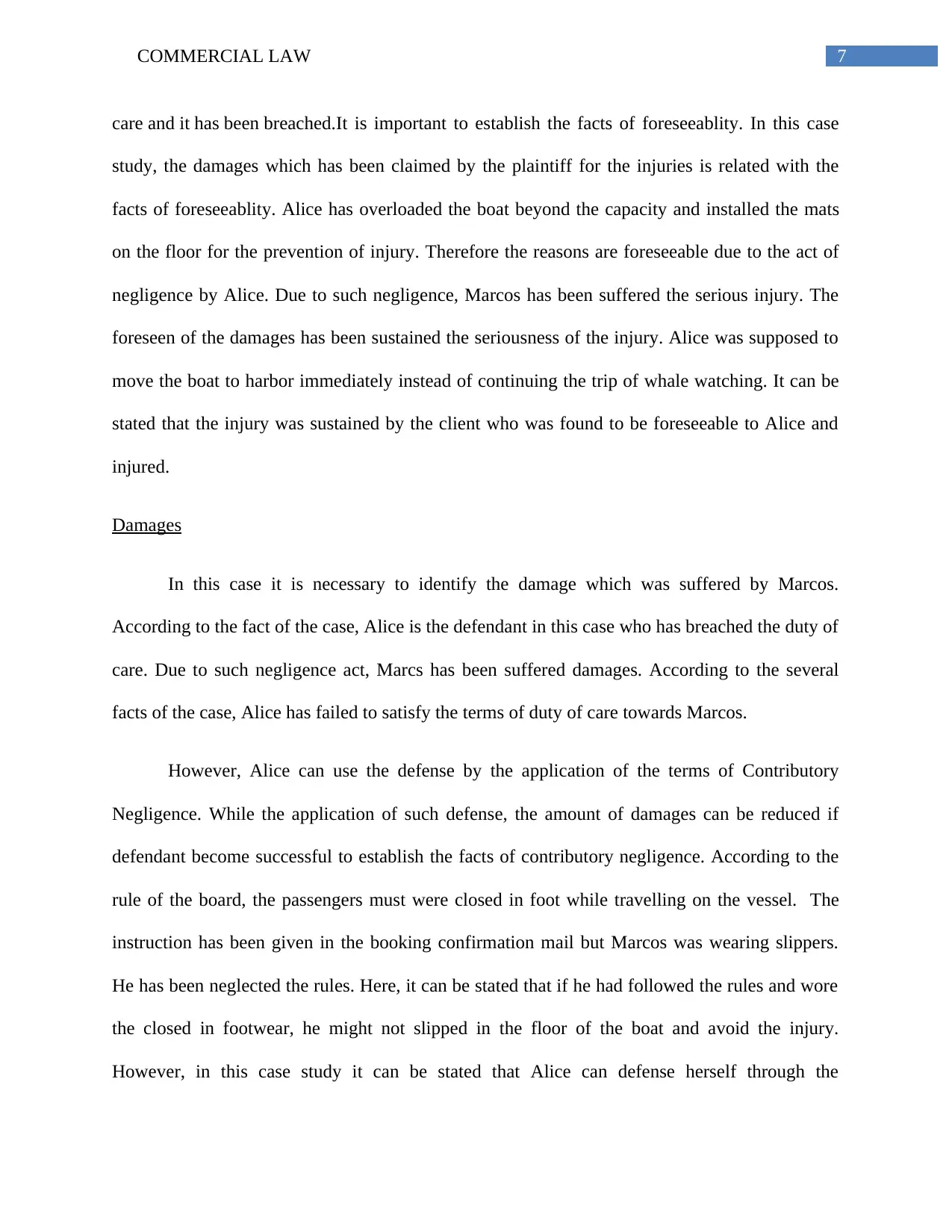
7COMMERCIAL LAW
care and it has been breached.It is important to establish the facts of foreseeablity. In this case
study, the damages which has been claimed by the plaintiff for the injuries is related with the
facts of foreseeablity. Alice has overloaded the boat beyond the capacity and installed the mats
on the floor for the prevention of injury. Therefore the reasons are foreseeable due to the act of
negligence by Alice. Due to such negligence, Marcos has been suffered the serious injury. The
foreseen of the damages has been sustained the seriousness of the injury. Alice was supposed to
move the boat to harbor immediately instead of continuing the trip of whale watching. It can be
stated that the injury was sustained by the client who was found to be foreseeable to Alice and
injured.
Damages
In this case it is necessary to identify the damage which was suffered by Marcos.
According to the fact of the case, Alice is the defendant in this case who has breached the duty of
care. Due to such negligence act, Marcs has been suffered damages. According to the several
facts of the case, Alice has failed to satisfy the terms of duty of care towards Marcos.
However, Alice can use the defense by the application of the terms of Contributory
Negligence. While the application of such defense, the amount of damages can be reduced if
defendant become successful to establish the facts of contributory negligence. According to the
rule of the board, the passengers must were closed in foot while travelling on the vessel. The
instruction has been given in the booking confirmation mail but Marcos was wearing slippers.
He has been neglected the rules. Here, it can be stated that if he had followed the rules and wore
the closed in footwear, he might not slipped in the floor of the boat and avoid the injury.
However, in this case study it can be stated that Alice can defense herself through the
care and it has been breached.It is important to establish the facts of foreseeablity. In this case
study, the damages which has been claimed by the plaintiff for the injuries is related with the
facts of foreseeablity. Alice has overloaded the boat beyond the capacity and installed the mats
on the floor for the prevention of injury. Therefore the reasons are foreseeable due to the act of
negligence by Alice. Due to such negligence, Marcos has been suffered the serious injury. The
foreseen of the damages has been sustained the seriousness of the injury. Alice was supposed to
move the boat to harbor immediately instead of continuing the trip of whale watching. It can be
stated that the injury was sustained by the client who was found to be foreseeable to Alice and
injured.
Damages
In this case it is necessary to identify the damage which was suffered by Marcos.
According to the fact of the case, Alice is the defendant in this case who has breached the duty of
care. Due to such negligence act, Marcs has been suffered damages. According to the several
facts of the case, Alice has failed to satisfy the terms of duty of care towards Marcos.
However, Alice can use the defense by the application of the terms of Contributory
Negligence. While the application of such defense, the amount of damages can be reduced if
defendant become successful to establish the facts of contributory negligence. According to the
rule of the board, the passengers must were closed in foot while travelling on the vessel. The
instruction has been given in the booking confirmation mail but Marcos was wearing slippers.
He has been neglected the rules. Here, it can be stated that if he had followed the rules and wore
the closed in footwear, he might not slipped in the floor of the boat and avoid the injury.
However, in this case study it can be stated that Alice can defense herself through the
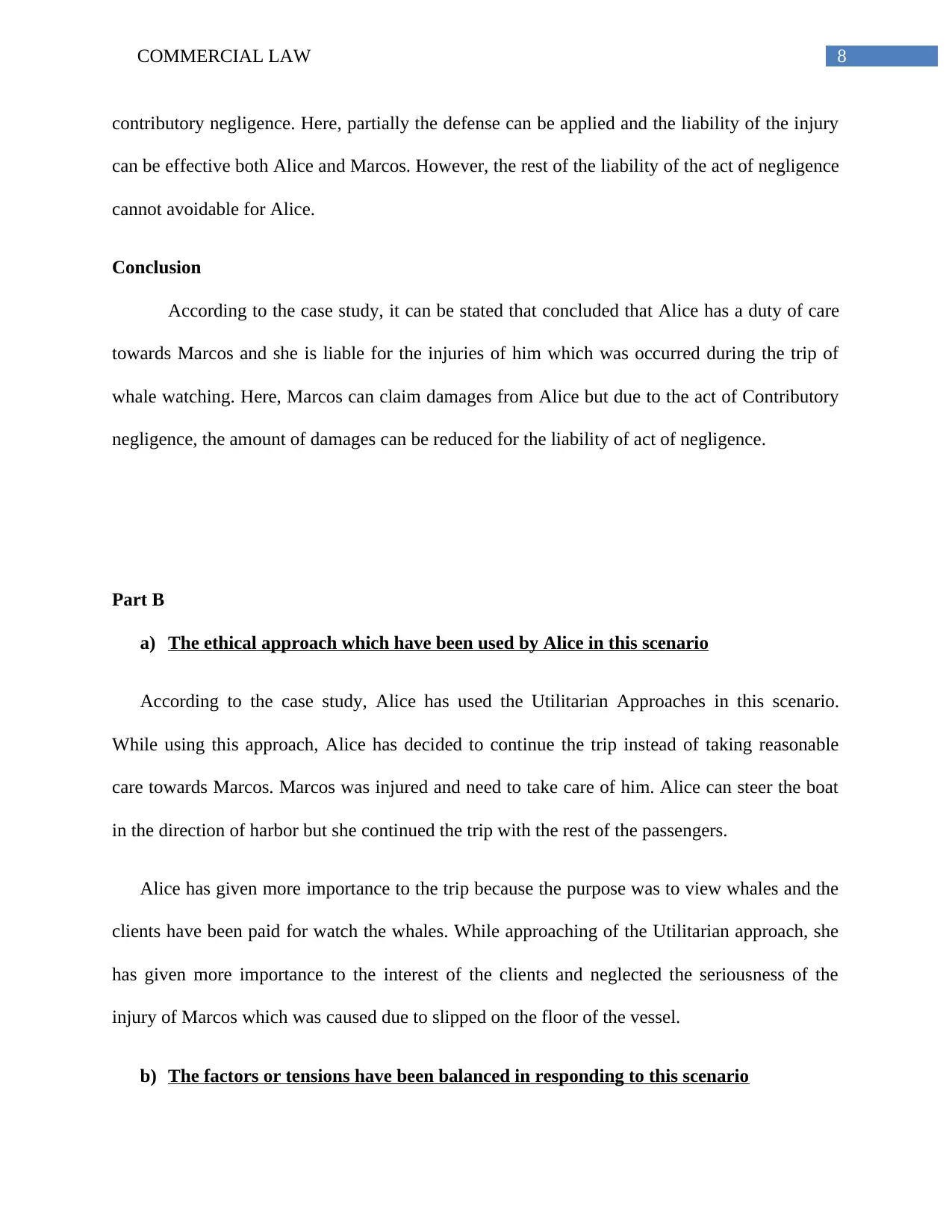
8COMMERCIAL LAW
contributory negligence. Here, partially the defense can be applied and the liability of the injury
can be effective both Alice and Marcos. However, the rest of the liability of the act of negligence
cannot avoidable for Alice.
Conclusion
According to the case study, it can be stated that concluded that Alice has a duty of care
towards Marcos and she is liable for the injuries of him which was occurred during the trip of
whale watching. Here, Marcos can claim damages from Alice but due to the act of Contributory
negligence, the amount of damages can be reduced for the liability of act of negligence.
Part B
a) The ethical approach which have been used by Alice in this scenario
According to the case study, Alice has used the Utilitarian Approaches in this scenario.
While using this approach, Alice has decided to continue the trip instead of taking reasonable
care towards Marcos. Marcos was injured and need to take care of him. Alice can steer the boat
in the direction of harbor but she continued the trip with the rest of the passengers.
Alice has given more importance to the trip because the purpose was to view whales and the
clients have been paid for watch the whales. While approaching of the Utilitarian approach, she
has given more importance to the interest of the clients and neglected the seriousness of the
injury of Marcos which was caused due to slipped on the floor of the vessel.
b) The factors or tensions have been balanced in responding to this scenario
contributory negligence. Here, partially the defense can be applied and the liability of the injury
can be effective both Alice and Marcos. However, the rest of the liability of the act of negligence
cannot avoidable for Alice.
Conclusion
According to the case study, it can be stated that concluded that Alice has a duty of care
towards Marcos and she is liable for the injuries of him which was occurred during the trip of
whale watching. Here, Marcos can claim damages from Alice but due to the act of Contributory
negligence, the amount of damages can be reduced for the liability of act of negligence.
Part B
a) The ethical approach which have been used by Alice in this scenario
According to the case study, Alice has used the Utilitarian Approaches in this scenario.
While using this approach, Alice has decided to continue the trip instead of taking reasonable
care towards Marcos. Marcos was injured and need to take care of him. Alice can steer the boat
in the direction of harbor but she continued the trip with the rest of the passengers.
Alice has given more importance to the trip because the purpose was to view whales and the
clients have been paid for watch the whales. While approaching of the Utilitarian approach, she
has given more importance to the interest of the clients and neglected the seriousness of the
injury of Marcos which was caused due to slipped on the floor of the vessel.
b) The factors or tensions have been balanced in responding to this scenario
⊘ This is a preview!⊘
Do you want full access?
Subscribe today to unlock all pages.

Trusted by 1+ million students worldwide
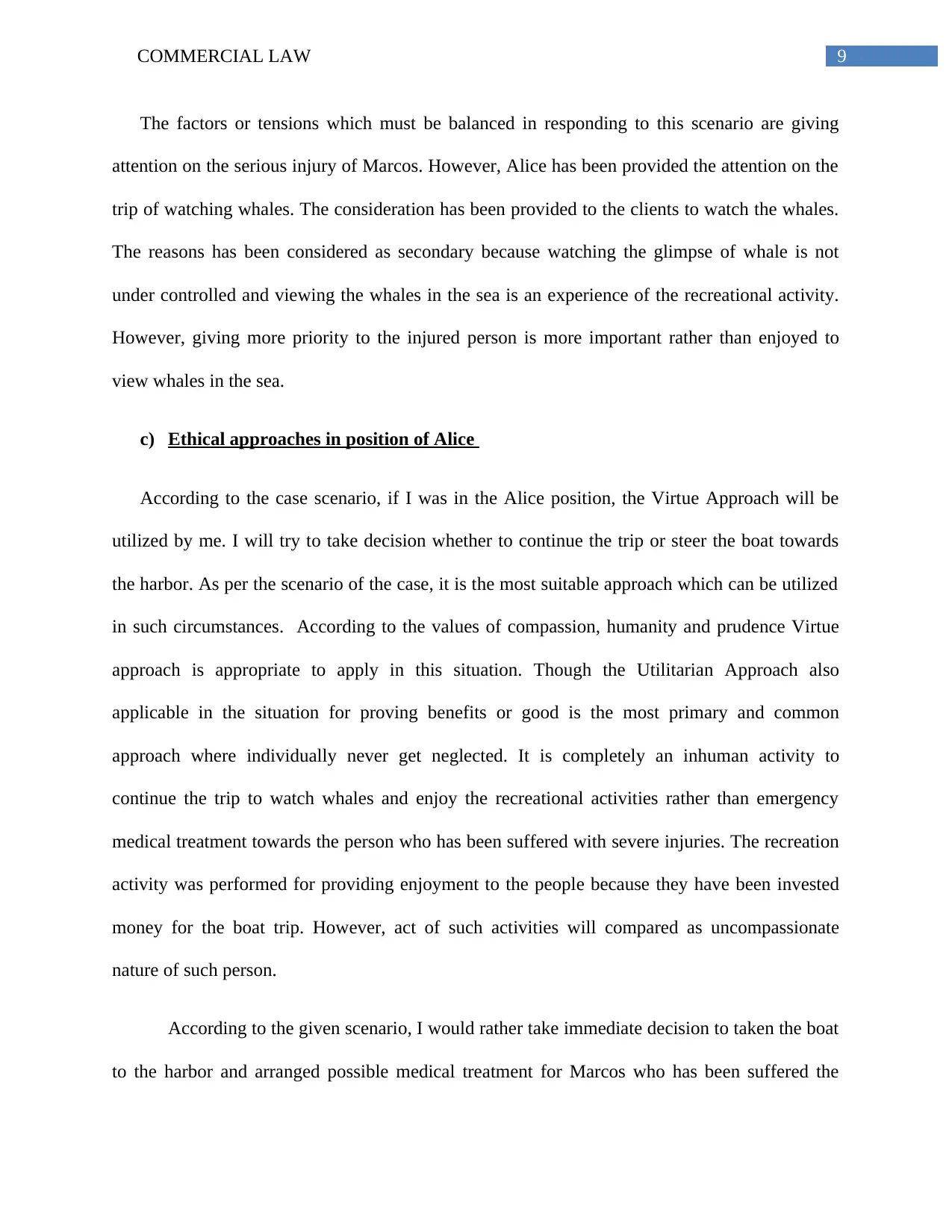
9COMMERCIAL LAW
The factors or tensions which must be balanced in responding to this scenario are giving
attention on the serious injury of Marcos. However, Alice has been provided the attention on the
trip of watching whales. The consideration has been provided to the clients to watch the whales.
The reasons has been considered as secondary because watching the glimpse of whale is not
under controlled and viewing the whales in the sea is an experience of the recreational activity.
However, giving more priority to the injured person is more important rather than enjoyed to
view whales in the sea.
c) Ethical approaches in position of Alice
According to the case scenario, if I was in the Alice position, the Virtue Approach will be
utilized by me. I will try to take decision whether to continue the trip or steer the boat towards
the harbor. As per the scenario of the case, it is the most suitable approach which can be utilized
in such circumstances. According to the values of compassion, humanity and prudence Virtue
approach is appropriate to apply in this situation. Though the Utilitarian Approach also
applicable in the situation for proving benefits or good is the most primary and common
approach where individually never get neglected. It is completely an inhuman activity to
continue the trip to watch whales and enjoy the recreational activities rather than emergency
medical treatment towards the person who has been suffered with severe injuries. The recreation
activity was performed for providing enjoyment to the people because they have been invested
money for the boat trip. However, act of such activities will compared as uncompassionate
nature of such person.
According to the given scenario, I would rather take immediate decision to taken the boat
to the harbor and arranged possible medical treatment for Marcos who has been suffered the
The factors or tensions which must be balanced in responding to this scenario are giving
attention on the serious injury of Marcos. However, Alice has been provided the attention on the
trip of watching whales. The consideration has been provided to the clients to watch the whales.
The reasons has been considered as secondary because watching the glimpse of whale is not
under controlled and viewing the whales in the sea is an experience of the recreational activity.
However, giving more priority to the injured person is more important rather than enjoyed to
view whales in the sea.
c) Ethical approaches in position of Alice
According to the case scenario, if I was in the Alice position, the Virtue Approach will be
utilized by me. I will try to take decision whether to continue the trip or steer the boat towards
the harbor. As per the scenario of the case, it is the most suitable approach which can be utilized
in such circumstances. According to the values of compassion, humanity and prudence Virtue
approach is appropriate to apply in this situation. Though the Utilitarian Approach also
applicable in the situation for proving benefits or good is the most primary and common
approach where individually never get neglected. It is completely an inhuman activity to
continue the trip to watch whales and enjoy the recreational activities rather than emergency
medical treatment towards the person who has been suffered with severe injuries. The recreation
activity was performed for providing enjoyment to the people because they have been invested
money for the boat trip. However, act of such activities will compared as uncompassionate
nature of such person.
According to the given scenario, I would rather take immediate decision to taken the boat
to the harbor and arranged possible medical treatment for Marcos who has been suffered the
Paraphrase This Document
Need a fresh take? Get an instant paraphrase of this document with our AI Paraphraser
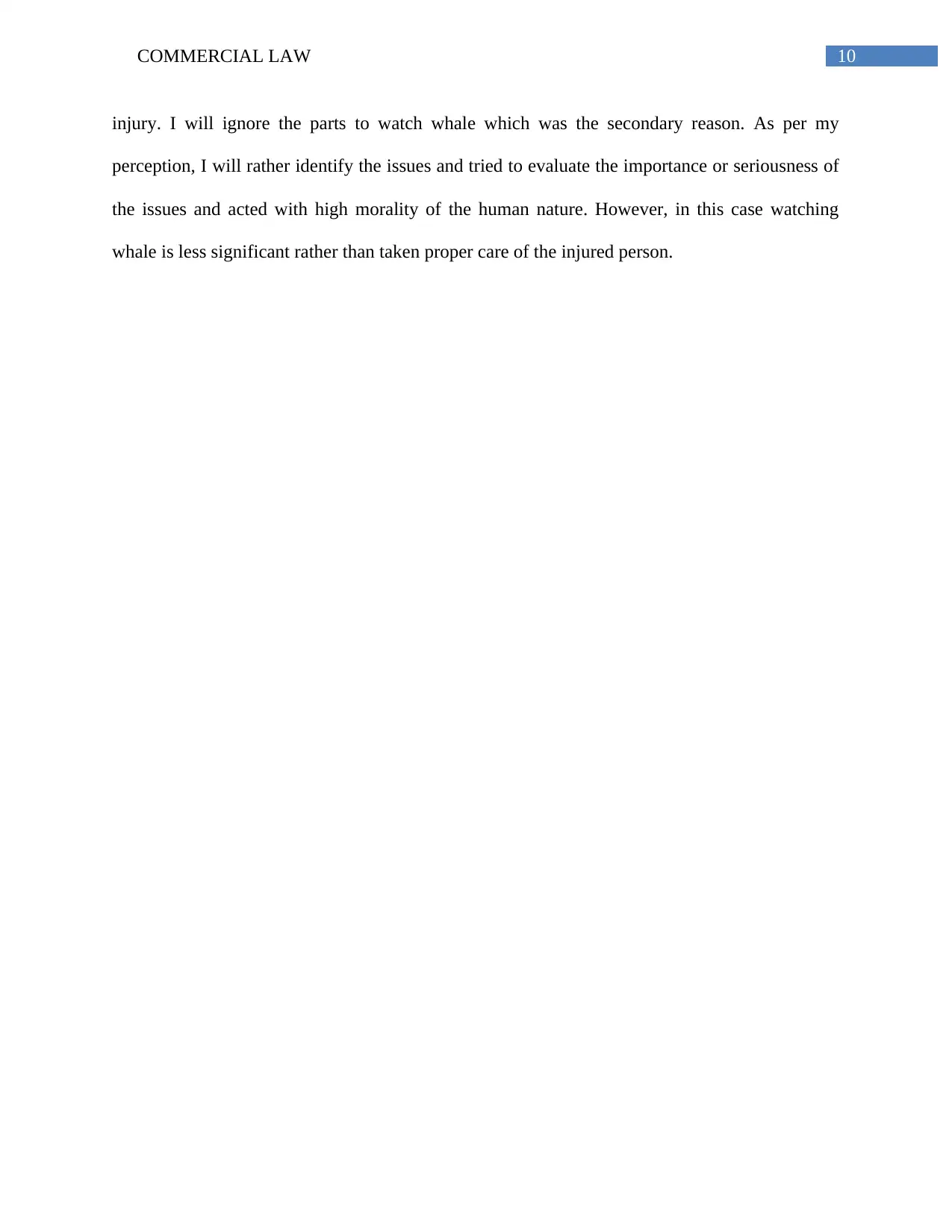
10COMMERCIAL LAW
injury. I will ignore the parts to watch whale which was the secondary reason. As per my
perception, I will rather identify the issues and tried to evaluate the importance or seriousness of
the issues and acted with high morality of the human nature. However, in this case watching
whale is less significant rather than taken proper care of the injured person.
injury. I will ignore the parts to watch whale which was the secondary reason. As per my
perception, I will rather identify the issues and tried to evaluate the importance or seriousness of
the issues and acted with high morality of the human nature. However, in this case watching
whale is less significant rather than taken proper care of the injured person.
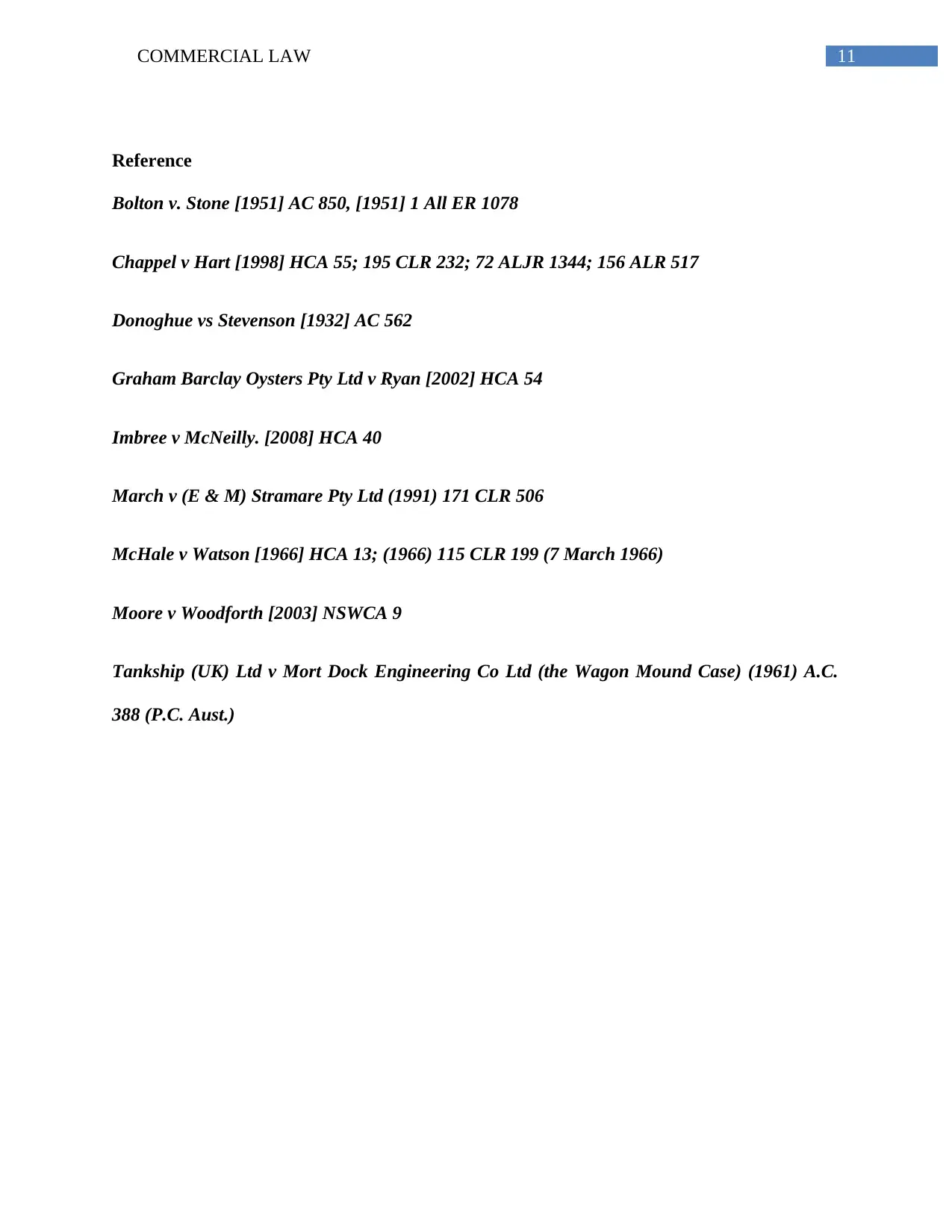
11COMMERCIAL LAW
Reference
Bolton v. Stone [1951] AC 850, [1951] 1 All ER 1078
Chappel v Hart [1998] HCA 55; 195 CLR 232; 72 ALJR 1344; 156 ALR 517
Donoghue vs Stevenson [1932] AC 562
Graham Barclay Oysters Pty Ltd v Ryan [2002] HCA 54
Imbree v McNeilly. [2008] HCA 40
March v (E & M) Stramare Pty Ltd (1991) 171 CLR 506
McHale v Watson [1966] HCA 13; (1966) 115 CLR 199 (7 March 1966)
Moore v Woodforth [2003] NSWCA 9
Tankship (UK) Ltd v Mort Dock Engineering Co Ltd (the Wagon Mound Case) (1961) A.C.
388 (P.C. Aust.)
Reference
Bolton v. Stone [1951] AC 850, [1951] 1 All ER 1078
Chappel v Hart [1998] HCA 55; 195 CLR 232; 72 ALJR 1344; 156 ALR 517
Donoghue vs Stevenson [1932] AC 562
Graham Barclay Oysters Pty Ltd v Ryan [2002] HCA 54
Imbree v McNeilly. [2008] HCA 40
March v (E & M) Stramare Pty Ltd (1991) 171 CLR 506
McHale v Watson [1966] HCA 13; (1966) 115 CLR 199 (7 March 1966)
Moore v Woodforth [2003] NSWCA 9
Tankship (UK) Ltd v Mort Dock Engineering Co Ltd (the Wagon Mound Case) (1961) A.C.
388 (P.C. Aust.)
⊘ This is a preview!⊘
Do you want full access?
Subscribe today to unlock all pages.

Trusted by 1+ million students worldwide
1 out of 12
Related Documents
Your All-in-One AI-Powered Toolkit for Academic Success.
+13062052269
info@desklib.com
Available 24*7 on WhatsApp / Email
![[object Object]](/_next/static/media/star-bottom.7253800d.svg)
Unlock your academic potential
Copyright © 2020–2025 A2Z Services. All Rights Reserved. Developed and managed by ZUCOL.





